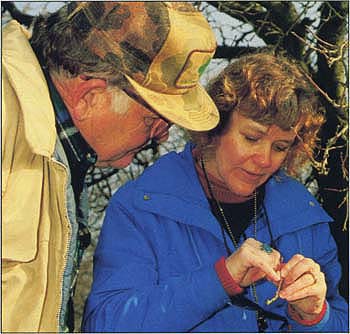All Issues
UC IPM: 20 years of progress
Publication Information
California Agriculture 54(6):4-6.
Published November 01, 2000
PDF | Citation | Permissions
Full text
Thank you to the many readers who responded to the “Future in focus: 2000–2025” series. In addition to these sample letters, we will publish others in the January-February 2001 issue. -Ed.
Demographics: Ag work force
I just finished Phil Martin's fine piece on California farmworkers in the January-February 2000 issue (p. 19). It provides the best summary I've seen of the current work-force situation, and difficulties in stabilizing our state's agriculture work force.
Several efforts are being undertaken in work-force stabilization, including an EDD pilot project with Central Valley growers, aimed at more fully coordinating the regional work force to the various harvests and work available. We hope to have this in operation by February 2001. Also, the UFW won a major Department of Labor grant in July 2000 for a project of skills upgrading to reduce seasonality among our existing work force.
Professor Martin is involved in our EDD efforts, and we value his great expertise and experience in agriculture work-force issues.
Michael S. Bernick
California Employment Development Department
Resources: Problems that need fixing
Congratulations and thank you for an exceptional issue [March-April 2000]. I learned much, and I am certain many others who need to know this material will learn much as well. I heartily approve of focus issues such as this one, especially when the content emphasizes major problems that need fixing rather than “you-can-have-your-cake-and-eat-it-too” articles that present a very limited perspective on the size and complexity of our state's problems.
Reginald H. Barrett
Professor of Wildlife Ecology & Management, UC Berkeley
"Agriculture's new millennium" biased
I find the July-August 2000 issue to be a biased platform to launch the vision of some people that hold power and research funds (mostly from private firms). The article by Sweezey (p. 26) is the only one that offers an alternative view, although it does not represent entirely the view of the alternative agriculture movement, which is opposed to biotechnology, precision farming, large-scale specialized farms, and instead promotes local food systems, based on agroecological techniques, and a more socially just and economically viable food system. I challenge you to bring these alternative views to your journal.
Miguel A. Altieri
Professor of Agroecology, UC Berkeley
Editor's note: As a peer-reviewed journal of research and review articles, California Agriculture welcomes submissions from UC scientists that are research-based and of interest to our audience.
Transgenic issues clarified
The July-August issue is outstanding, especially the genetic engineering articles! There is too much bad mouthing and fear regarding scientific work on transgenic plants and animals and too little effort to clarify the benefits as well as the potential problems in terms that lay people can understand. It would be great if the Extension specialists could help this along in cooperation with other campus-based faculty. Thanks for this “collectors” edition!
Hunter Johnson
Extension Specialist Emeritus, UC Riverside
Food security and Salmonella
The September-October issue contains an excellent article written by Dr. Kinde (p. 62). The article makes a convincing argument that Salmonella enteritidis (SE) phage type 4 infection in California got its start in humans. I would argue that this helps explain why we haven't seen it in egg-type chicken breeding flocks in California. Dr. Kinde argues that turkey flocks clean of pullorum thyphoid in most developed countries are not infected with SE, and that countries where S. pullorum and S. gallinarum are still prevalent have significant problems with SE. I would argue that essentially all—or at least a high percentage—of broiler and broiler breeding flocks in the United States and Canada are free of SE.
Andrew R. Rhorer, Senior Coordinator
USDA National Poultry Improvement Plan
VISIT California Agriculture's new web site at http://danr.ucop.edu/calag
Our new Web site includes:
-
Full text of Recent Issues (Year 2000 research articles in PDF format, news sections in HTML)
-
Past Issues containing news sections, tables of contents, and abstracts going back to 1996
-
Indexes going back to 1996
We will be adding more features as we go. Your feedback and suggestions are welcome. Write us at CALAG@ucop.edu.
UC scientists began cautioning growers in the 1950s not to rely on a single pest-control approach, and developed path-breaking integrated pest management (IPM) techniques. Since its inception 20 years ago, the UC Statewide IPM Project has helped growers reduce the pesticide load in the environment; enhance the predictability and effectiveness of pest control techniques; develop pest-control programs that are economically, environmentally and socially acceptable; and increase use of natural pest controls.
Shortly after its inception, the IPM Project helped the tomato industry reliably manage fruitworm with monitoring and treatment guidelines. Growers cut costs and improved worker safety by reducing multiple sprays and targeting pesticide applications so that less toxic pesticides could be used.
“That's the beauty of IPM,” says Bob Curtis, manager of IPM programs for Campbell Soup Supply Company. “It's a win-win-win-win situation for the environment, consumer, worker and grower. The grower gets improved practices at a cheaper price, the consumer gets a better quality product, worker safety is enhanced and practices are friendlier to the environment.”
The UC IPM Project also works closely with California-licensed pest control advisers (PCAs). Kim Crum, executive director of the California Agricultural Production Consultants Association (CAPCA), confirms, “For the past two decades, CAPCA and its more than 3,700 members have worked toward implementation and information dissemination of the UCIPM Project.”
Research funded by the IPM Project is primarily conducted by scientists on UC's Berkeley, Davis and Riverside campuses, but also by UC farm advisors and the seven IPM advisors located around the state. These are a few examples of their recent achievements:
- ■
Replacement of organophosphates with the biologically based products Bacillus thuringiensis and spinosad for peach twig borer in stone fruit (p. 14)
- ■
Solarization of soil as an alternative to methyl bromide (p. 42)
- ■
Mass release of Trichogramma wasps to manage codling moth (p. 22)
- ■
Evaluation of parasites for red gum lerp psyllid control (p. 8)
- ■
Development of alternative weed-control methods (pp. 30,37)
- ■
Coordination of the Pest Management Alliances (p. 26)
Education and publications
The IPM Education and Publications group has published 13 manuals covering California's top crops. A 14th book, Integrated Pest Management for Floriculture and Nursery Crops, will be released in spring 2001. More than 76,000 copies of the manuals have been sold. These manuals and the frequently updated UC IPM Pest Management Guidelines, which cover 42 crops, help PCAs and growers identify pests and natural enemies, recognize the environmental and ecological factors that have brought on pest problems, adopt or adapt reliable monitoring practices, and rely on multiple management alternatives.
Although developing IPM information for major agricultural crops was the first priority of the UC IPM Project, as time went on, they recognized the needs of urban audiences.
“There is an increased realization that pesticides are used and misused in urban areas, particularly by homeowners,” says Frank Zalom, director of the IPM Project. “The misuse of pesticides in urban areas can contribute to environmental problems that affect all of California's population, and result in further restrictions on uses of certain products. UC's IPM information also can have an environmental impact by lessening reliance on broadly toxic pesticides.”
The Project has sold nearly 40,000 copies of Pests of the Garden and Small Farm and Pests of Landscape Trees and Shrubs. The books provide comprehensive IPM programs for home gardeners and professional landscapers. A CD-ROM, “The UC Guide to Solving Garden and Landscape Problems” was released in 2000 and is used in every UC Master Gardener office to diagnose and suggest management methods for garden and landscape pests. It is also for sale to the general public and has been extremely popular-the Los Angeles Times (Sept. 28,2000) described it as “the best single reference on plant problems for Californians.”
The Pest Note series, featuring more than 80 home and landscape pests as diverse as bermudagrass, cockroaches, powdery mildew, headlice and house mice, is also an important part of IPM urban outreach.
Web site expands access
Since 1980, UC IPM has supported development of computerized tools for on-farm decision-making. Databases and utilities were created to assist research and extension, and the system allowed researchers to develop, test and distribute other pest management-related resources.
“The rapid increase of personal computer use and the implementation of our databases and materials on the Web has made access to UC's IPM information possible for literally millions of users,” Zalom says.
The information systems group has been involved in implementing a wide variety of tools used on personal computers, such as expert systems in cotton and rice, utilities such as degree-day calculators and trap data spreadsheets, and databases such as the state Department of Pesticide Regulation Pesticide Use Reports.
These resources are accessible via the Internet, along with a catalog of publications, educational programs and software. The Web site includes UC's official guidelines for managing pests in major crops and in the home and landscape. Thousands of color photographs help users accurately identity pest problems. Temperatures, rainfall and other weather data arrive daily from about 200 stations throughout California.
Use of the Web site has grown exponentially, from 7,000 page accesses per month in 1995-96, the first year of the site, to an average of 342,000 per month this year.
Use of the Web site has grown exponentially, from 7,000 page accesses per month in 1995-96 …to an average of 342,000 per month this year.
Future challenges
Although the Project continues to produce research innovations, getting them integrated into practice is a challenge.
“There are relatively few sources of research funding to adapt the basic discoveries to meet real world needs,” Zalom explains. “Managing time and resources within UC and finding new opportunities to permit the transfer of IPM knowledge will be a major problem to be addressed.”
Zalom has been careful to adhere to the mission that was established for the project by the California Legislature.
“External pressures are constantly challenging the program-financial, political and otherwise—and it would be easy to have the program inadvertently redirected to the problem of the moment or the most current political whim,” he says. “It is essential that the program continue to take a long-term perspective of IPM, and continue to direct its attention to issues that will move us closer to the biologically based management of pests while enhancing the profitability of our agricultural community.”
— Pam Kan-Rice
Clarification on chocolate and flavonoids
Several recent research reports, including California Agriculture's September/October issue (p. 33) have suggested that naturally occurring flavonoids in cocoa and chocolate have antioxidant properties that may be good for the cardiovascular system. Flavonoids comprise about 10% to 12% by weight of cocoa beans, the starting material for chocolate products.
However, every step of chocolate manufacturing, from harvest to the shelf, has the potential to reduce flavonoid levels in the finished product, including:
- ɚ
Fermentation. After harvesting, cocoa beans are fermented for varying amounts of time to imbue flavor.
- ɚ
Drying. Cocoa beans are then dried, reducing water activity in order to stop fermentation and prevent mold.
- ɚ
Chocolate-making. Beans are then roasted, milled into a paste and blended with other ingredients.
- ɚ
Final steps. Dutching or alkalization may be undertaken to increase the product's pH.
The nutrient content of any plant-based food, including cocoa beans, depends upon cultivar type, growing region, farming practices, postharvest handling and finally, processing and storage.
At present, consumers who wish to know the flavonoid content of their chocolate must seek additional information from the manufacturer in question. Sheryl Lazarus and Harold Schmitz of Mars, Inc., authors of the previously mentioned article, note that Mars'products with higher flavonoid content carry a “Cocoapro” trademark. Mars collaborates with universities and research institutes globally, and has advanced research on the health benefits of cocoa and chocolate.
—Editor






